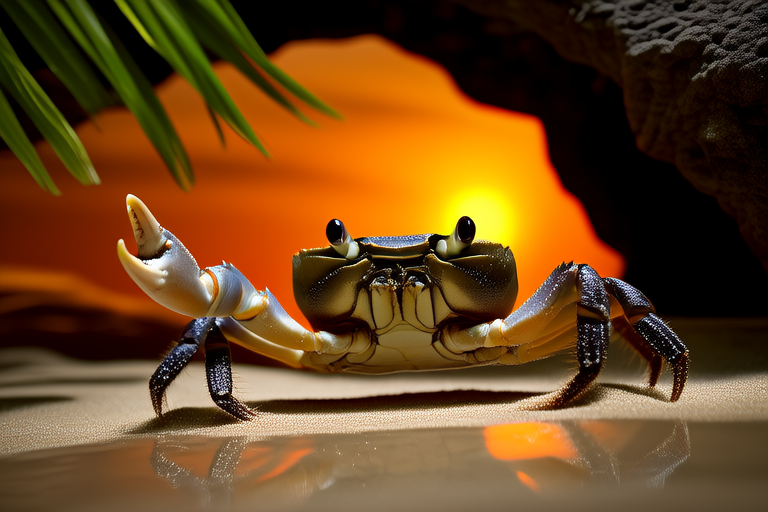Crabby Vibes Only: Essential Tips for Keeping Your Hermit Crab Happy
Welcome to the world of hermit crabs! These delightful creatures can make wonderful pets if you provide them with the right environment. This guide will walk you through setting up an ideal habitat, feeding them properly, maintaining humidity and temperature, choosing safe substrates, enriching their lives, recognizing signs of health, and debunking common myths about hermit crab care.
Setting Up the Ideal Habitat
Your hermit crab’s home should mimic their natural environment as closely as possible. Start by selecting an appropriately sized tank; a 10-gallon aquarium is suitable for one or two crabs, but more space is better if you plan to house multiple crabs. Ensure there’s plenty of ventilation, as hermit crabs need fresh air.
Incorporate climbing structures such as branches, cork bark, and driftwood. These provide exercise opportunities and mental stimulation. Add hiding spots like small caves or coconut halves. A variety of shells in different sizes and shapes ensures that your crabs can find new homes when they outgrow their current ones.
Diet Specifics
Hermit crabs are omnivores, enjoying a mix of plant-based and animal-based foods. Offer them a balanced diet including commercial hermit crab food, fruits like apples and bananas, vegetables like carrots and spinach, and protein sources like boiled eggs or fish. Avoid feeding them processed human foods high in salt or sugar.
Provide fresh water daily in a shallow dish. Change it frequently to prevent contamination. Some owners also offer saltwater, which helps with molting. However, ensure that any salt used is specifically formulated for marine animals and not table salt.
Maintaining Proper Humidity and Temperature
Hermit crabs thrive in humid environments, so maintaining optimal conditions is crucial. Aim for humidity levels between 70% and 80%. Use a hygrometer to monitor this. If necessary, increase humidity by misting the enclosure regularly or adding a water dish large enough for the crabs to soak in.
Temperature plays a significant role too. Maintain temperatures between 75°F and 85°F (24°C to 29°C). You can achieve this using heat lamps or under-tank heaters. Always place thermometers inside the enclosure to track temperature changes accurately.
Safe Substrate OptionsSelecting appropriate substrate is vital for your hermit crab’s well-being. Opt for organic materials like coconut fiber, crushed coral, or play sand. These substrates promote burrowing behavior, which is essential for physical activity and stress relief.
Avoid using gravel, wood chips, or cat litter as these can be harmful if ingested. Additionally, ensure that any substrate you choose does not contain harmful chemicals or additives.
Enrichment Activities
To keep your hermit crabs mentally stimulated, introduce enrichment activities into their routine. Rotate toys periodically to maintain interest. Provide items like empty egg cartons, cardboard tubes, and plastic containers with holes drilled in them. These serve as tunnels and hideouts, encouraging exploration and play.
Consider creating mazes or obstacle courses within the tank using non-toxic materials. This not only provides entertainment but also promotes physical fitness. Remember that enrichment activities should always be supervised to prevent injury.
Signs of a Healthy Versus a Stressed Crab
Healthy hermit crabs display vibrant colors, active movement, and regular shell switching. They eat consistently and show curiosity towards their surroundings. Conversely, signs of stress include lethargy, reluctance to move, refusal to eat, and prolonged periods spent in one spot.
If you notice any unusual behaviors or physical changes, consult a veterinarian specializing in exotic pets immediately. Early intervention can prevent serious health issues.
Common Myths About Hermit Crab Care Debunked
There are several misconceptions surrounding hermit crab care. One prevalent myth is that hermit crabs require minimal attention once set up correctly. While initial setup requires effort, ongoing maintenance is necessary to ensure long-term happiness and health.
Another common belief is that hermit crabs can survive solely on commercial pet store food. While convenient, this diet lacks nutritional diversity. Supplementing with fresh foods enhances overall well-being.
Some people mistakenly think hermit crabs don’t need social interaction. In reality, hermit crabs benefit from companionship and enjoy interacting with each other. Providing ample space and resources allows them to coexist peacefully.
Lastly, there’s confusion regarding how often hermit crabs molt. Molting occurs periodically throughout their lifespan, usually every few months. During this time, they become more sensitive and may appear inactive. Ensuring proper environmental conditions supports successful molting.
By understanding and addressing these myths, you’ll be better equipped to provide the best care for your hermit crabs.
Conclusion
Raising happy and healthy hermit crabs involves creating a nurturing environment that meets all their needs. From setting up the perfect habitat to providing nutritious meals and engaging activities, every aspect contributes to their well-being. By staying informed and attentive, you can ensure your little crabby friends live long, fulfilling lives.
